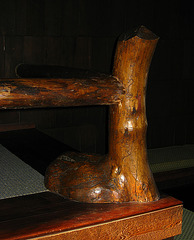Ron's Log's photos with the keyword: phallus
Asmat Bis Poles - from Papua New Guinea (7650)
| 16 Apr 2008 |
|
"Asmat Bis Poles: Form and Imagery
"Each Asmat bis pole is carved from a single piece of wood. To create the pole's distinctive form, carvers select trees with plank-like buttress roots. During carving, all but one of the roots are removed, and the tree is inverted, so that the remaining root forms the wing-like projection ( cemen ) at the top. Bis poles consist of several components. The main section ( bis anakat ) with the carved figures portrays the deceased individual for whom the pole is named and other recently deceased relatives. The cemen represents the pole's phallus and incorporates motifs symbolic of headhunting, which is also associated with fertility. The lower portion of the pole is called the ci (canoe) and at times depicts the canoe that transported the ancestors to the afterworld ( safan ). The pointed base ( bino ) is often inserted into the ground."
Asmat Bis Poles - from Papua New Guinea (7649)
| 16 Apr 2008 |
|
"Asmat Bis Poles: Form and Imagery
"Each Asmat bis pole is carved from a single piece of wood. To create the pole's distinctive form, carvers select trees with plank-like buttress roots. During carving, all but one of the roots are removed, and the tree is inverted, so that the remaining root forms the wing-like projection ( cemen ) at the top. Bis poles consist of several components. The main section ( bis anakat ) with the carved figures portrays the deceased individual for whom the pole is named and other recently deceased relatives. The cemen represents the pole's phallus and incorporates motifs symbolic of headhunting, which is also associated with fertility. The lower portion of the pole is called the ci (canoe) and at times depicts the canoe that transported the ancestors to the afterworld ( safan ). The pointed base ( bino ) is often inserted into the ground."
Asmat Bis Pole - from Papua New Guinea (7652)
| 16 Apr 2008 |
|
"Asmat Bis Poles: Form and Imagery
"Each Asmat bis pole is carved from a single piece of wood. To create the pole's distinctive form, carvers select trees with plank-like buttress roots. During carving, all but one of the roots are removed, and the tree is inverted, so that the remaining root forms the wing-like projection ( cemen ) at the top. Bis poles consist of several components. The main section ( bis anakat ) with the carved figures portrays the deceased individual for whom the pole is named and other recently deceased relatives. The cemen represents the pole's phallus and incorporates motifs symbolic of headhunting, which is also associated with fertility. The lower portion of the pole is called the ci (canoe) and at times depicts the canoe that transported the ancestors to the afterworld ( safan ). The pointed base ( bino ) is often inserted into the ground."
Asmat Bis Pole - from Papua New Guinea (7651)
| 16 Apr 2008 |
|
|
"Asmat Bis Poles: Form and Imagery
"Each Asmat bis pole is carved from a single piece of wood. To create the pole's distinctive form, carvers select trees with plank-like buttress roots. During carving, all but one of the roots are removed, and the tree is inverted, so that the remaining root forms the wing-like projection ( cemen ) at the top. Bis poles consist of several components. The main section ( bis anakat ) with the carved figures portrays the deceased individual for whom the pole is named and other recently deceased relatives. The cemen represents the pole's phallus and incorporates motifs symbolic of headhunting, which is also associated with fertility. The lower portion of the pole is called the ci (canoe) and at times depicts the canoe that transported the ancestors to the afterworld ( safan ). The pointed base ( bino ) is often inserted into the ground."
Asmat Bis Pole - from Papua New Guinea (0774)
| 16 Apr 2008 |
|
"Asmat Bis Poles: Form and Imagery
"Each Asmat bis pole is carved from a single piece of wood. To create the pole's distinctive form, carvers select trees with plank-like buttress roots. During carving, all but one of the roots are removed, and the tree is inverted, so that the remaining root forms the wing-like projection ( cemen ) at the top. Bis poles consist of several components. The main section ( bis anakat ) with the carved figures portrays the deceased individual for whom the pole is named and other recently deceased relatives. The cemen represents the pole's phallus and incorporates motifs symbolic of headhunting, which is also associated with fertility. The lower portion of the pole is called the ci (canoe) and at times depicts the canoe that transported the ancestors to the afterworld ( safan ). The pointed base ( bino ) is often inserted into the ground."
Camp Walter Art Piece (4879)
| 06 Sep 2013 |
|
|
Phallus In A Sling (0348)
| 10 Sep 2011 |
|
Phallus (0322)
| 09 Sep 2011 |
|
Old Faithful Inn (3984)
| 04 Oct 2009 |
|
Ashtray (2641)
| 26 May 2009 |
|
Desert Cathedral (3470)
| 10 Mar 2009 |
|
Desert Cathedral (3468)
| 10 Mar 2009 |
|
Flaming Phallus Art Car (1186)
| 20 Sep 2008 |
|
Flaming Phallus Art Car (1185)
| 20 Sep 2008 |
|
Phallic Cactus
| 01 Aug 2008 |
|
Cabot's Pueblo Museum Pipe (8206)
| 16 Dec 2007 |
|
Jump to top
RSS feed- Ron's Log's latest photos with "phallus" - Photos
- ipernity © 2007-2025
- Help & Contact
|
Club news
|
About ipernity
|
History |
ipernity Club & Prices |
Guide of good conduct
Donate | Group guidelines | Privacy policy | Terms of use | Statutes | In memoria -
Facebook
Twitter
















